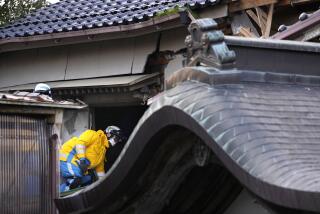Workers suffer hardships in effort to stabilize Fukushima plant
They sleep with just one blanket apiece anywhere there’s space — in a conference room, in the hallway, near the bathroom. Because deliveries of supplies are limited, they get by on very little food: Breakfast is packages of high-calorie emergency crackers and a small carton of vegetable juice; dinner consists of a small bag of “magic rice” (just add bottled water) and a can of chicken, mackerel or curry. There is no lunch — handing out a noontime meal would be too complicated in the crowded two-story building.
These are the grueling, Spartan living conditions for workers at the Fukushima nuclear power plant who are racing to connect electric cables, repair machinery and check equipment in order to avert a meltdown at the facility 150 miles northeast of Tokyo.
A Japanese nuclear regulatory official who spent five days at the power plant as an observer on Monday gave reporters the first detailed look at what life is like for the hundreds of workers remaining at the facility.
Photos: Japan’s earthquake, tsunami and nuclear crisis
When they are pumping radioactive water from basements or repairing machinery in control rooms, the workers breathe through respirators and dress in white suits with hoods that cover them from head to toe, which offer substantial protection but are not foolproof. Even the short periods that they spend near the reactors — they work in one-hour shifts — can expose them to dangerously high radiation levels. Hundreds of workers sleep and eat in one huge room, about 6,200 square feet, on the second floor of a building a short distance from the reactor sites.
“I don’t think the workers have the energy they need to work under these extremely tough conditions,” said Kazuma Yokota, who heads the Japanese Nuclear and Industrial Safety Agency’s local office in charge of inspections at the plant. The facility’s operator, Tokyo Electric Power Co., or Tepco, did not immediately respond to Yokota’s comments.
Health and safety measures for the Fukushima workers have come under increased scrutiny after three were exposed to highly radioactive water last week. Tepco has admitted it did not adequately warn the men about the potential danger of the water in reactor No. 3, even thought it had known about highly radioactive water days earlier at reactor No. 1. The company apologized for the lack of communication but at the same time said that the men, who have placed their lives at risk, had themselves ignored alarms alerting them to the radiation levels.
The company came under new criticism Monday after it retracted data indicating it had detected radiation levels 10 million times normal levels. Not that the correction was reassuring: The levels, Tepco said, were actually about 100,000 times those found at a normally functioning reactor.
“These things are an indication that they don’t have good control on radiation protection,” said Edwin Lyman, a senior scientist in the global security program at the Union of Concerned Scientists. “If you can’t make accurate measurements, if you ignore alarms … it’s a sign of chaos, and it means that there is pressure to keep going.”
Nineteen workers have been exposed to more than 100 millisieverts of radiation since the crisis at the facility after the March 11 earthquake and tsunami, the Mainichi newspaper reported Monday, quoting Tepco. In the United States, the normal radiation exposure limit for nuclear power plant workers is 50 millisieverts per year; Japan has raised its legal limit to 250 millisieverts because the work is considered so urgent and crucial.
“If radiation levels continue to increase, workers are going to have their dose limits challenged even at this emergency level,” Lyman said. “Workers could get saturated within a few weeks or even less.
“Or they will have to raise the limits again.”
In the days immediately after the quake, when explosions rocked the plant, Tepco evacuated 750 workers but 50 stayed behind to try to contain the crisis. They quickly became folk heroes, with some people referring to them as “the Fukushima 50” or modern-day samurai. Reinforcements have since boosted their numbers to 400, and workers are being rotated in and out to limit their exposure to radiation.
Twice a day, a bus packed with a new shift of workers and supplies drives into the heart of the Fukushima plant. The workers are divided into working groups of specialists, such as electricians or control room operators. Their daily routine depends on the tasks at hand, how many workers are available, and the level of radiation exposure
Yokota, the nuclear safety agency official, said that during his five days at the plant, he was exposed to 883 microsieverts of radiation, the equivalent of about nine chest X-rays (1,000 microsieverts is 1 millisievert). Even inside the building where workers stay to avoid radiation, they are constantly exposed to low levels, he said.
Skilled workers will be needed for months, if not longer, to repair the plant.
Dr. Robert Peter Gale, an American physician who is advising Japan’s government on the health of staffers at the plant, said doctors are “under pressure” and are weighing whether to begin harvesting and banking blood cells from hundreds of workers, measures that could help save their lives later. Gale, who also advised on the 1986 Chernobyl disaster, said about 200 workers there were subjected to high levels of radiation, and 13 eventually got bone marrow transplants.
As authorities consider how to cope in the long run, Yokota’s account indicates that deliveries of food and other basic supplies to the plant, as well as hygiene and communication with the outside world, remain a challenge.
The workers drink bottled water — they are each allotted about 50 ounces a day — but don’t have running water to wash their hands or bodies because the plumbing is broken. Instead, they use an alcohol spray.
“Some have expressed concern about not being able to change their underwear,” said Yokota, who himself looked haggard after his experience, with bags under his eyes and a patchy beard.
There’s no way for workers to talk to their families because the quake toppled nearby cellphone towers, he added. The plant’s phone lines are still down and so the only means of communicating with the outside world is via satellite phone, Yokota said. That’s a direct line to Tepco headquarters and is not available for personal calls. Some details about the conditions at the plant, however, have emerged through Twitter feeds and email.
Masato Kino, a spokesman for the nuclear safety agency at Fukushima, elaborated later on Yokota’s observations, saying the employees were driven by a strong sense of mission and responsibility.
When the exhausted workers drop off to sleep, they put down radiation-protection mats on any available space on the floor, Yokota said. “We want to help as much as we can to improve their working conditions,” he said.
Hall is a special correspondent.
More to Read
Start your day right
Sign up for Essential California for news, features and recommendations from the L.A. Times and beyond in your inbox six days a week.
You may occasionally receive promotional content from the Los Angeles Times.







